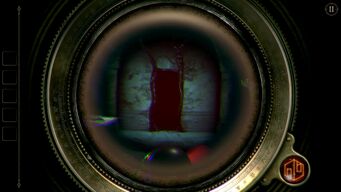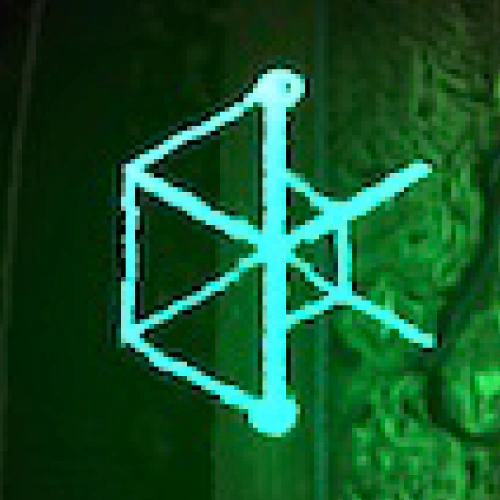
Null portals are interdimensional gateways opened by the Null, or the entities associated with the Null. Stepping through a gateway allows a person to transport themselves across time and space, though they may not be in control of where they end up. Portals may be opened unintentionally, in response to interaction with raw Null, or purposefully, through use of room glyphs or doorway machines.
Characteristics[]
The appearances of Null portals may vary depending on the situation. Generally, the edges of such portals are overgrown with dark Null tendrils, which may cling to the surface that the doorway is opened upon or within. The space surrounding a Null portal may take on the appearance of its location, such as retaining the wallpaper of the wall it was summoned on.
Looking through the portal may or may not reveal the next location. Sometimes, the appearance of an actual door within the real world can be seen. Other times, however, the doorway appears completely dark, or blindingly white. Larger Null tendrils are seen to lurk within the spaces between connected doorways, and may extend outside the doors to chase travelers or destroy structures.
Summoning and Use[]
"Every time I see the symbol, the doorway appears to take me to God knows where by means still a mystery to me." - The Protagonist
In The Room Two, AS observes that in order to summon a Null portal, the user must "tune the room to find the glyph, and tune the glyph to find the door", and that "all must be aligned", though he does not understand why this is. He calls the repetitive pattern of rooms and doors a "world of worlds", a "place of endless places". The places conjured by AS are apprently places he had visited in life, though he notes that there is some "tang of reality that is quite missing" and that he detects the "lime and greasepaint" - some sort of disguise or facade about the place. It could be that the locations the Null conjures are only facsimiles of the true places. The space within the doorways would appear, then, to be some sort of pocket dimension which leads victims of the Null on to their eventual fate. For AS, this fate was to become imprisoned in the safes and boxes devised by The Craftsman. Those who become trapped in this dimension are compelled to move forward through the doorways by their own curiosity, which only becomes more insatiable and maddening the longer they continue. The victim is usually beholden to the whims of the Null, but, as demonstrated by AS, can alter the path by sacrificing their soul in some way.
The Craftsman avoids becoming trapped in the maze of the Null by using doorway machines. These machines allow the user to summon a portal to a specific location, without relying on the Null.
The doorway is most often accompanied by the main hexagonal glyph which appears in all the games. This would seem to imply that the symbol itself has something to do with interdimensional travel.
Occurrences[]
In The Room[]
Prior to the game's events, A.S. opens his house to the influence of the Null dimension through his experiments, and eventually manages to summon and travel through a portal. When all of the puzzles in A.S.'s Manor are solved, the Protagonist is able to follow him through the first portal to the Cog Room. The portal is a doorway seen through a Greyhenge arch. The liminal spaces within these portals are bright white. As the player emerges, they pass by arms of clockwork and machinery, zoom in close on a Null sample, and then find themselves in the Cog Room for the epilogue.
In the Epilogue, A.S. describes the sensation of traveling through the portal as "Not quite turning, not quite falling." He also mentions that the visions he had been experiencing related to the Null vanished once he entered the door, perhaps because they had only been motivators to bring him there. As he moves forward, the way back closes and a new way opens ahead. The portals do not abide by A.S.'s wishes, but rather seem to control where he moves.
At the end of the Epilogue, after tuning two room glyphs, a new Null portal appears in a red sigil flash. The force of its appearance breaks the player's eyepiece. The doorway itself seems to be made of grey stone, though not in the standing-stones shape as with Greyhenge. Null tendrils are wrapped across its surface. As the player approaches it, the screen fades to black.
In The Room Two[]
The story of The Room Two takes the player across several places in time, leading them through a number of doorways. For the first three levels (The Crypt, The Ship, and The Temple), the Protagonist must find and tune a room glyph which opens the next door. They also learn of A.S.'s journey as he preceded them through the Null dimension. A.S. had apparently been traveling for a much longer time, and through many more doors, to the point that the ledger he used to keep track of the doors was entirely filled with tally marks. By the time he left his note in The Temple, he had begun to completely despair, likening the endless cycle of rooms, room glyphs, and doors to being in Hell.
By The Séance, A.S. has learned of a way to control where the doorways take you. However, in order to do so, a soul must be provided. A.S. chooses to sacrifice his own soul to ensure that the Protagonist can get home. The Séance ends not with a doorway being opened, but with the Protagonist being forcibly teleported to the rowboat of The Crossing. They physically reel themselves into shore, where the next level, The Lab, waits.
A.S.'s soul is used to power the doorway machine in Montfaucon's lab, which opens a door to the Cog Room. At the center of this room is an altar, with two room glyphs to be tuned. As the player cycles through the different symbols on the altar sliders, different doors will appear beyond the gateway. When the correct glyph is reached, the final doorway opens, back to A.S.'s Manor and his and the Protagonist's original time.
In The Room Three[]
Most of the portals seen in The Room Three are created by The Craftsman's doorway machines. The machines allow The Craftsman to control the end destination of each doorway. Travel is localized to the different rooms of Grey Holm, with no time-jumps. Without the use of these doorways, The Craftsman would not be able to navigate Grey Holm, as he would be subject to the whims of the Null.
The Craftsman can also navigate to a certain extent using The Craftsman's Key. The Key, when used on the Grey Holm font altar, opens a doorway that transports the user (slightly jarringly) to the highest tower. The shakiness of the journey through this door may suggest it is an unstable form of transportation.
On the high tower, where the final puzzle is located, is one more of The Craftsman's contraptions - a projector which, when connected to The Craftsman's Key, opens an unnaturally powerful doorway. The contraption seems to be an unusual variation of doorway machine, used to reach places that would normally be inaccessible to mundane Null users. The Craftsman aims to use this doorway to trap the Protagonist in a prison dimension. Once they are trapped, he would use the Protagonist's soul to power yet another doorway, one that is blindingly white. However, this machine can be used in other ways, as shown in the game's three alternate endings. Using found artifacts, the Protagonist can change the end destination of this doorway to the surface of Mars or the Grey Holm boat house. Depending on which of the boat house endings the player achieves, the Protagonist may find that the opening of the doorway for their escape has brought aberrations of the Null along with them, placing the world in grave danger.
In The Room: Old Sins[]
There are few Null portals seen in The Room: Old Sins, as Collector Hydrus visits different rooms in the Dollhouse by entering through seals and does not need to travel far across time and space. However, in the final sequence of the game, The Attic, the player must manipulate a wooden doll of Edward Lockwood through miniature portals connecting the rooms of the Dollhouse. This represents Edward's final moments of life, struggling through the maze of doors in his manor while trying to find Abigail.
In The Room VR: A Dark Matter[]
The Room VR: A Dark Matter once again sees the player transported to a new location with a unique theme for each level. However, unlike previous games, they do not travel between locations by walking through portals at first. Instead, they are transported to the nexus or the next location automatically when interacting with visions and/or soul-trap artifacts. Transportation is presumably initiated by The Craftsman, though the means is unclear.
Only after completing The Witch's level does the player return to the nexus through a portal. The Witch's cottage contains an unusual interdimensional gateway. The space within it is an empty void into which the Null can summon a silver of any location. It is the same void that The Craftsman first summoned The Detective to, where they return after each level. The Detective is able to summon locations beyond this door using The Witch's Tarot cards, while The Witch herself does not need to use them. This door may not be considered a portal through the Null so much as a passage into it. When The Witch's level is completed, the doorway in her house opens, and the player walks through it to return to the nexus.
Throughout the game, The Detective recovers soul-trap artifacts which The Craftsman uses to slowly summon a stone portal in the void. The Witch refers to this portal as "The White Doorway", and says that it is very dangerous. To stop The Craftsman, The Witch summons a gateway in the void to the Egyptian desert, where the source of his power lies.
Later, after The Craftsman is trapped and all the souls have been freed, The Witch summons the door and front steps of The Detective's Office in the void in order to send them home.
